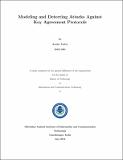| dc.contributor.advisor | Mathuria, Anish M. | |
| dc.contributor.author | Yadav, Anshu | |
| dc.date.accessioned | 2017-06-10T14:39:35Z | |
| dc.date.available | 2017-06-10T14:39:35Z | |
| dc.date.issued | 2012 | |
| dc.identifier.citation | Yadav, Anshu (2012). Modeling and detecting attacks against key agreement protocols. Dhirubhai Ambani Institute of Information and Communication Technology, xi, 112 p. (Acc.No: T00340) | |
| dc.identifier.uri | http://drsr.daiict.ac.in/handle/123456789/377 | |
| dc.description.abstract | Key agreement protocols establish a shared secret key between two or more communicating
parties willing to exchange data over insecure channels using symmetric key cryptography.
Based on the number of members involved in the communication these protocols can be
classied as a two party or group key agreement protocols. Various formal methods are
available in the literature to analyze the security of such protocols. This helps in establishing
the validity of any attacks, if found, or to prove the security of the protocols under given
adversarial assumptions. In this thesis we analyze the security of several existing two party
and group key agreement protocols. We used provable security models like eCK'08 and
enhanced eCK and the DS model given as an algebraic approach by Delicata and Schneider to
analyze a class of DH based key agreement protocols. The distinguishing feature of key
agreement protocols from key transport protocols is that the former aims to ensure the
contribution of all the honest participants so that no one can predetermine the key. In a
poorly designed protocol, an insider adversary can control the key in different forms as dened
by Pieprzyk and Wang. This type of attack is termed as key control. We also dene ephemeral
key control w.r.t. dishonest insider where it is assumed that the adversary also knows the
ephemeral secret of the victim honest participants. This assumption is based on several
advanced attributes that assume ephemeral leakage. We analyze this attack on MTI protocols
using DS model. We have shown weakness in some provably secure two party implicitly
authenticated protocols and modeled the attacks in provable security model. We also
analyzed key control in some group key agreement protocols. We have used the DS model to
formally derive an attack shown by Pieprzyk on Burmester-Desmedt protocol and have also
proposed attacks on static version of the group key agreement protocol proposed by Dutta
and Barua. | |
| dc.publisher | Dhirubhai Ambani Institute of Information and Communication Technology | |
| dc.subject | Computer security | |
| dc.subject | Security measures | |
| dc.subject | Computer network protocols | |
| dc.subject | Data encryption | |
| dc.subject | Public key infrastructure | |
| dc.subject | Computer security | |
| dc.subject | Key agreement protocols | |
| dc.subject | Cryptographic protocols | |
| dc.classification.ddc | 005.82 YAD | |
| dc.title | Modeling and detecting attacks against key agreement protocols | |
| dc.type | Dissertation | |
| dc.degree | M. Tech | |
| dc.student.id | 201011001 | |
| dc.accession.number | T00340 | |

